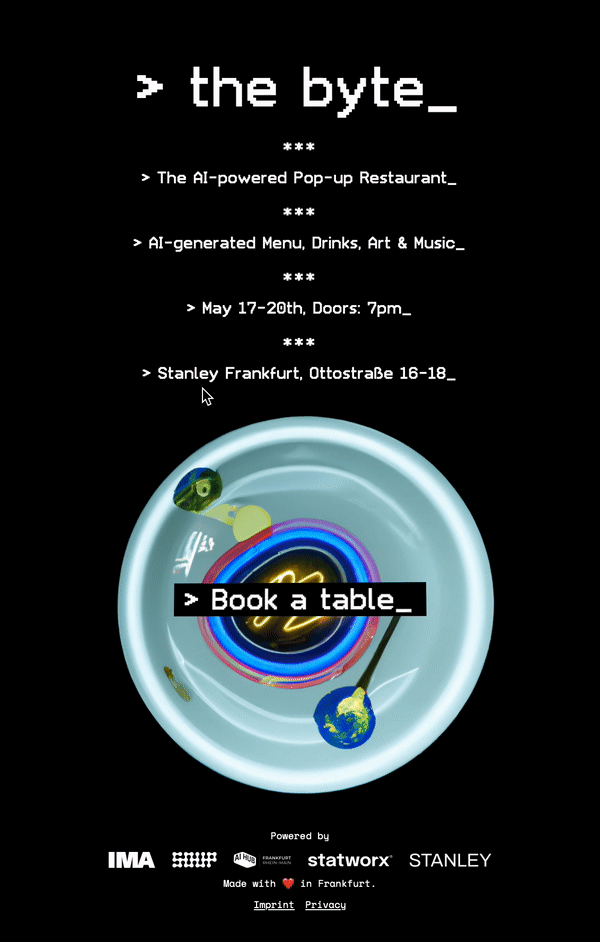AI chatbots are quickly becoming essential in businesses, but not all chatbots are created equal. Some can be set up swiftly with ease, yet they often lack the customizability and advanced features that could truly elevate performance, like enhancing customer service responses. Tailor-made solutions that do offer those capabilities can become complex and costly, particularly when they include sophisticated, use-case-specific technologies like Retrieval-Augmented Generation (RAG) that enhance the precision and reliability of generative AI models, allowing them to converse using a company’s own databases and produce verified facts.
How do chatbots work?
Custom GPT-chatbots absorb vast amounts of text to comprehend contexts and identify patterns. They’re programmed to respond personally to various user inquiries, with customization to specific needs, training with selected data, and integration into platforms such as websites or mobile apps.
statworx’s CustomGPT stands out by combining the best of both worlds: high customizability with quick implementation. This tailor-made solution offers secure and efficient use of ChatGPT-like models, with interfaces that can be designed in a company’s brand style and easily integrated into existing business applications like CRM systems and support tools.
So, what’s crucial when companies seek the ideal chatbot solution?
Requirement Analysis: First, a company’s specific needs should be pinpointed to ensure the chatbot is perfectly tailored. What tasks should it handle? Which departments should it support? What functionalities are necessary?
Model Training: A custom GPT-chatbot needs to be equipped with relevant data and information to assure high accuracy and responsiveness. If the necessary data isn’t available, the technical effort might not be justifiable.
System Integration: Seamless integration of the chatbot into existing communication channels like websites, apps, or social media is crucial for effective use. Different solutions may suit different infrastructures.
Ready to deploy and adaptable
The CustomGPT-chatbot from statworx is notable for its quick setup, often within weeks, thanks to a mix of proven standard solutions and custom adjustments. It allows file uploads and the ability to chat, extracting secure information from the company’s own data. With advanced features like fact-checking, data filtering, and user feedback integration, it stands apart from other systems.
Moreover, CustomGPT gives companies the freedom to choose their chatbot’s vocabulary, communication style, and overall tone, enhancing brand experience and recognition through personalized, unique interactions. It’s also optimized for mobile displays on smartphones.
Technical Implementation
On the technical front, Python is the core language for CustomGPT’s backend, with statworx developers utilizing FastAPI, a modern web framework that supports both Websockets for stateful communication and a REST API for services. CustomGPT is versatile, suitable for various infrastructures, from a simple cloud function to a machine cluster if needed.
A key feature of its architecture is the connection to a data layer, providing a flexible backend that can quickly adapt to changing conditions and requirements. The frontend application, built with React, seamlessly interacts with the backend, which, for example, leverages the powerful Azure AI search function. This configuration allows for the implementation of custom search solutions and efficient fulfillment of specific requirements.
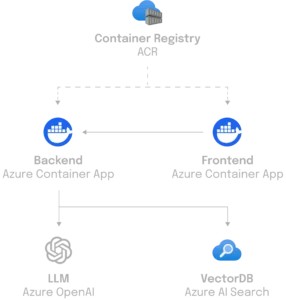
The benefits at a glance:
Data Protection and Security
CustomGPT ensures all data is stored and processed within the European Union, with full control retained by the company, setting it apart from other GPT-based solutions.
Integration and Flexibility
Its flexible integration into existing business applications is supported by modularity and vendor independence, allowing CustomGPT to adapt to various infrastructures and models, including open-source options.
Features and Customization
CustomGPT’s customization includes integration with organizational data, user role adaptation, and the use of analytics to enhance conversations, offering flexibility and personalization for corporate applications.
Personalized Customer Experience
By tailoring to a company’s specific needs, Custom GPT-chatbots can provide personalized and effective customer interactions.
Efficient Customer Support
CustomGPT chatbots can answer questions, resolve issues, and provide information around the clock, increasing customer satisfaction and efficiency.
Scalability
Companies can effortlessly scale their customer support capacity with GPT-chatbots to maintain consistent service quality, even during high demand.
The time for your own chatbot is now. Therefore, statworx focuses on upstream development with quick deployment and easy implementation. This means all users of a statworx CustomGPT benefit from patches, bug fixes, and new features over time. CustomGPT remains versatile and flexible, meeting the specific, changing needs of companies and addressing complex requirements. Contact us now for a consultation.
Imagine it’s Friday and instead of the usual office routine, you find yourself in the middle of a hackathon for a pro bono project, planning a trip to the Dialogue Museum at Frankfurt’s Hauptwache, or asking passers-by on the Zeil about their thoughts on AI and sustainability. What do all these diverse activities have in common? They are part of the 4:1 week (“Four to one”) at statworx – a work model that provides space for personal development, innovative work, and social engagement.
Why did we introduce the 4:1 week?
At statworx, we faced a challenge: Our employees had great ambitions for further education but found little time for it. The workweek was filled with projects and appointments, and personal development often took a back seat.
To solve this dilemma, we introduced an innovative work structure in 2022: the 4:1 week. The principle is simple and effective. Four days of the week are dedicated to intensive work on projects. The fifth day, Friday, is all about further education. On this day, business goes on at a reduced pace, and employees can fully dedicate themselves to their professional and personal development.
This new structure has led to a noticeable change. It allows every individual at statworx to pursue further education and learn new skills, even during busy times. This not only promotes personal development but also the company’s innovative strength. While customer projects receive full attention from Monday to Thursday, Friday becomes a space for learning and inspiration. This way, we collectively maintain a balance between customer needs and employee development.
What training opportunities does statworx offer?
statX: Once a month, employees voluntarily meet to exchange insights from projects, personal knowledge, or new models and approaches. Topics range from deep learning with audio data to the AI Act and anomaly detection.
Clusters: The self-organized workgroups are the breeding ground for the development and promotion of expertise at statworx. Currently, there are fifteen clusters where employees can delve into topics that are particularly close to their hearts – thereby strengthening statworx’s overall innovation power. Here are three examples from our cluster portfolio:
- Bio Medicine Cluster: Development of AI applications in the biomedical and pharmaceutical fields.
- NLP Cluster: Implementation of state-of-the-art models, best practices, and software for NLP, as well as multimodal applications of NLP models.
- Explainable AI Cluster: Engagement with methods to make black box AI models transparent and explainable.
Training Budget: Each team member at statworx has an annual training budget. This budget can be used for individual training measures such as online courses, external trainings, participation in conferences, certifications, and much more.
Technical and Non-Technical Trainings: Throughout the year, we offer a variety of trainings that develop both soft and hard skills. From effective communication and constructive feedback to software engineering and Scrum, numerous exciting topics are covered.
How do we know that our 4:1 concept works?
Through regular pulse surveys and our biannual employee satisfaction surveys, we collect anonymized feedback on the 4:1 model. This gives us insights into our team members’ personal experiences. Additional direct conversations with employees provide us with further valuable impressions to decide how we will shape and develop the program in the future.
Our interim conclusion is that with every certificate earned and each personal success story, the 4:1 week at statworx proves its effectiveness. We look forward to continuously refining the concept and supporting even more employees on their individual learning journey.
Colleagues confirm our preliminary conclusion:
“The 4:1 week gives me the opportunity to delve deeper into topics and areas of knowledge that I’m passionate about, alongside my project work. That’s why I, along with my colleagues, initiated the Bio-Medicine Cluster. And I contribute my software engineering skills to the Cluster for Technical Delivery to continuously improve the technical deployment of our solutions.” – Benedikt Batton, Consultant Data Science, AI Development
“The 4:1 week promotes individual professional development and provides space to create value in innovative ways beyond existing departments and hierarchies. In my time at statworx, work on Fridays has always been a source of motivation, inspiration, and self-fulfillment.” – Max Hilsdorf, Consultant, AI Academy
Would you like to be part of a work culture that makes space for personal development and a balanced ratio between project work and further education? Then visit our career page and apply now!
Have you ever imagined a restaurant where AI powers everything? From the menu to the cocktails, hosting, music, and art? No? Ok, then, please click here.
If yes, well, it’s not a dream anymore. We made it happen: Welcome to “the byte” – Germany’s (maybe the world’s first) AI-powered Pop-up Restaurant!
As someone who has worked in data and AI consulting for over ten years, building statworx and the AI Hub Frankfurt, I have always thought of exploring the possibilities of AI outside of typical business applications. Why? Because AI will impact every aspect of our society, not just the economy. AI will be everywhere – in school, arts & music, design, and culture. Everywhere. Exploring these directions of AI’s impact led me to meet Jonathan Speier and James Ardinast from S-O-U-P, two like-minded founders from Frankfurt, who are rethinking how technology will shape cities and societies.
S-O-U-P is their initiative that operates at the intersection of culture, urbanity, and lifestyle. With their yearly “S-O-U-P Urban Festival” they connect creatives, businesses, gastronomy, and lifestyle people from Frankfurt and beyond.
When Jonathan and I started discussing AI and its impact on society and culture, we quickly came up with the idea of an AI-generated menu for a restaurant. Luckily, James, Jonathan’s S-O-U-P co-founder, is a successful gastro entrepreneur from Frankfurt. Now the pieces came together. After another meeting with James in one of his restaurants (and some drinks), we committed to launching Germany’s first AI-powered Pop-up Restaurant: the byte!
the byte: Our concept
We envisioned the byte to be an immersive experience, including AI in as many elements of the experience as possible. Everything, from the menu to the cocktails, music, branding, and art on the wall: everything was AI-generated. Bringing AI into all of these components also pushed me far beyond of what I typically do, namely helping large companies with their data & AI challenges.
Branding
Before creating the menu, we developed the visual identity of our project. We decided on a “lo-fi” appeal, using a pixelated font in combination with AI-generated visuals of plates and dishes. Our key visual, a neon-lit white plate, was created using DALL-E 2 and was found across all of our marketing materials:
Location
We hosted the byte in one of Frankfurt’s coolest restaurant event locations: Stanley, a restaurant location that features approx. 60 seats and a fully-fledged bar inside the restaurant (ideal for our AI-generated cocktails). The atmosphere is rather dark and cozy, with dark marble walls, highlighted with white carpets on the table, and a big red window that lets you see the kitchen from outside.

The menu
The heart of our concept was a 5-course menu that we designed to elevate the classical Frankfurter cuisine with the multicultural and diverse influences of Frankfurt (for everyone, who knows the Frankfurter kitchen, I am sure you know that this was not an easy task).
Using GPT-4 and some prompt engineering magic, we generated several menu candidates that were test-cooked by the experienced Stanley kitchen crew (thank you, guys for this great work!) and then assembled into a final menu. Below, you can find our prompt to create the menu candidates:
“Create a 5-course menu that elevates the classical Frankfurter kitchen. The menu must be a fusion of classical Frankfurter cuisine combined with the multicultural influences of Frankfurt. Describe each course, its ingredients as well as a detailed description of each dish’s presentation.”
Surprisingly, only minor adjustments were necessary to the recipes, even though some AI creations were extremely adventurous! This was our final menu:
- Handkäs’ Mousse with Pickled Beetroot on Roasted Sourdough Bread
- Next Level Green Sauce (with Cilantro and Mint) topped with a Fried Panko Egg
- Cream Soup from White Asparagus with Coconut Milk and Fried Curry Fish
- Currywurst (Beef & Vegan) by Best Worscht in Town with Carrot-Ginger-Mash and Pine Nuts
- Frankfurt Cheesecake with Äppler Jelly, Apple Foam and Oat-Pecanut-Crumble
My favorite was the “Next Level” Green Sauce, an oriental twist of the classical 7-herb Frankfurter Green Sauce topped with a fried panko egg. Yummy! Below you can see the menu out in the wild 🍲

AI Cocktails
Alongside the menu, we also prompted GPT to create recipes that twisted famous cocktail classics to match our Frankfurt fusion theme. The results:
- Frankfurt Spritz (Frankfurter Äbbelwoi, Mint, Sparkling Water)
- Frankfurt Mule (Variation of a Moscow Mule with Calvados)
- The Main (Variation of a Swimming Pool Cocktail)
My favorite was the Frankfurt Spritz, as it was fresh, herbal, and delicate (see pic below):
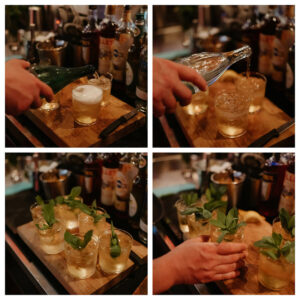
AI Host: Ambrosia the Culinary AI
An important part of our concept was “Ambrosia”, an AI-generated host that guided the guests around the evening, explaining the concept and how the menu was created. We thought it was important to manifest the AI as something the guests can experience. We hired a professional screenwriter for the script and used murf.ai to create several text-2-speech assets that were played at the beginning of the dinner and in-between courses.
Note: Ambrosia starts talking at 0:15.
AI Music
Music plays an important role for the vibe of an event. We decided to use mubert, a generative AI start-up that allowed us to create and stream AI music in different genres, such as “Minimal House” for a progressive vibe throughout the evening. After the main course, a DJ took over and accompanied our guests into the night 💃🍸
AI Art
Throughout the restaurant, we placed AI-generated art pieces by the local AI artist Vladimir Alexeev (a.k.a. “Merzmensch”), here are some examples:

AI Playground
As an interactive element for the guests, we created a small web app that takes the first name of a person and transforms it into a dish, including a reasoning why that name perfectly matches the dish 🙂 You can try it out here: Playground
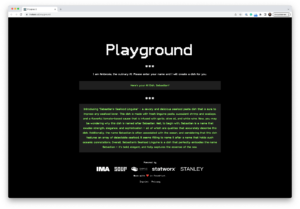
Launch
The byte was officially announced at the S-O-U-P festival press conference in early May 2023. We also launched additional marketing activities through social media and our friends and family networks. As a result, the byte was fully booked for three days straight, and we got broad media coverage in various gastronomy magazines and the daily press. The guests were (mostly) amazed by our AI creations, and we received inquiries from other European restaurants and companies interested in exclusively booking the byte as an experience for their employees 🤩 Nailed it!
Closing and Next Steps
Creating the byte together with Jonathan and James was an outstanding experience. It further encouraged me that AI will transform not only our economy but all aspects of our daily lives. There is massive potential at the intersection of creativity, culture, and AI that is currently only being tapped.
We definitely want to continue the byte in Frankfurt and other cities in Germany and Europe. Moreover, James, Jonathan, and I are already thinking of new ways to bring AI into culture and society. Stay tuned! 😏
The byte was not just a restaurant; it was an immersive experience. We wanted to create something that had never been done before and did it – in just eight weeks. And that’s the inspiration I want to leave you with today:
Trying new things that move you out of your comfort zone is the ultimate source of growth. You never know what you’re capable of until you try. So, go out there and try something new, like building an AI-powered pop-up restaurant. Who knows, you might surprise yourself. Bon apétit!
Impressions

Media
Genuss Magazin: https://www.genussmagazin-frankfurt.de/gastro_news/Kuechengefluester-26/Interview-James-Ardinast-KI-ist-die-Zukunft-40784.html
Frankfurt Tipp: https://www.frankfurt-tipp.de/ffm-aktuell/s/ugc/deutschlands-erstes-ai-restaurant-the-byte-in-frankfurt.html
Foodservice: https://www.food-service.de/maerkte/news/the-byte-erstes-ki-restaurant-vor-dem-start-55899?crefresh=1
statworx at Big Data & AI World
From media to politics, and from large corporations to small businesses, artificial intelligence has finally gained mainstream recognition in 2023. As AI specialists, we were delighted to represent statworx at one of the largest AI expos in the DACH region, “Big Data & AI World,” held in our hometown of Frankfurt. This event centered around the themes of Big Data and Artificial Intelligence, making it an ideal environment for our team of AI experts. However, our purpose went beyond mere exploration and networking. Visitors had the opportunity to engage in an enthralling Pac-Man game with a unique twist at our booth. In this post, we aim to provide you with a comprehensive overview of this exhilarating expo.
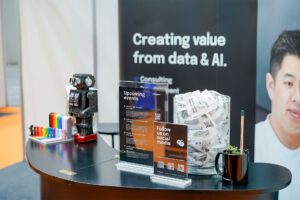
Fig. 1: our exhibition stand
Tangible AI Experience
Our Pac-Man challenge, where we provided booth visitors with an up-close encounter of the captivating world of artificial intelligence, emerged as a clear crowd favorite. Through our arcade machine, attendees not only immersed themselves in the timeless retro game but also witnessed the remarkable capabilities of modern technology. Leveraging AI, we analyzed players’ real-time facial expressions to discern their emotions. This fusion of cutting-edge technology and an interactive gaming experience was met with exceptional enthusiasm.
Our AI solution for emotion analysis of players ran seamlessly on a powerful M1-chip-equipped MacBook, enabling real-time image processing and fluid graphics display. The facial recognition of the players was made possible by a smart algorithm that instantly detected all the faces in the video. Subsequently, the face closest to the camera was selected and focused on, ensuring precise analysis even amidst long queues. Further processing involved a Convolutional Neural Network (CNN), specifically the ResNet18 model, which accurately detected players’ emotions.
Functioning as a multimedia server, our backend processed the webcam stream, facial recognition algorithms, and emotion detection. It could be operated either on-site using a MacBook or remotely in the cloud. Thanks to this versatility, we developed an appealing frontend to vividly present the real-time analysis results. Additionally, after each game, the results were sent to the players via email by linking the model with our CRM system. For the email, we created a digital postcard that provides not only screenshots of the most intense emotions but also a comprehensive evaluation.
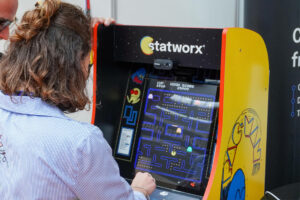
Fig. 2: Visitor at Pac-Man game machine
Artificial Intelligence – Real Emotions
Our Pac-Man challenge sparked excitement among expo visitors. Alongside the unique gaming experience on our retro arcade machine, participants gained insights into their own emotional states during gameplay. They were able to meticulously observe the prevailing emotions at different points in the game. Often, a slight surge of anger or sadness could be measured when Pac-Man met an untimely digital demise.
However, players exhibited varying reactions to the game. While some seemed to experience a rollercoaster of emotions, others maintained an unwavering poker face that even the AI could only elicit a neutral expression from. This led to intriguing conversations about how the measured emotions corresponded with the players’ experiences. It was evident, without the need for AI, that visitors left our booth with positive emotions, driven in part by the prospect of winning the original NES console we raffled among all participants.
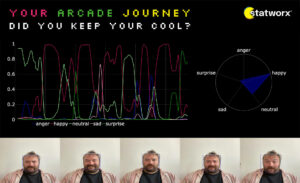
Fig. 3: digital post card
The AI Community on the Move
The “Big Data & AI World” served not only as a valuable experience for our company but also as a reflection of the burgeoning growth in the AI industry. The expo offered a platform for professionals, innovators, and enthusiasts to exchange ideas and collectively shape the future of artificial intelligence.
The energy and enthusiasm emanating from the diverse companies and startups were palpable throughout the aisles and exhibition areas. Witnessing the application of AI technologies across various fields, including medicine, logistics, automotive, and entertainment, was truly inspiring. At statworx, we have already accumulated extensive project experience in these domains, fostering engaging discussions with fellow exhibitors.
Our Conclusion
Participating in the “Big Data & AI World” was a major success for us. The Pac-Man Challenge with emotion analysis attracted numerous visitors and brought joy to all participants. It was evident that it wasn’t just AI itself but particularly its integration into a stimulating gaming experience that left a lasting impression on many.
Overall, the expo was not only an opportunity to showcase our AI solutions but also a meeting point for the entire AI community. The sense of growth and energy in the industry was palpable. The exchange of ideas, discussions about challenges, and the establishment of new connections were inspiring and promising for the future of the German AI industry.
What to expect:
The konaktiva at the Technical University of Darmstadt is one of the oldest and largest student business contact fairs and is organized annually by students. With over 10,000 visitors last year and more than 200 booths, konaktiva is the ideal opportunity for companies, students and graduates to get in touch with each other.
This year statworx is again represented at konaktiva with a booth and several colleagues. We will be at the fair on one of the three days (May 9th to May 11th) and will announce the exact date here as soon as we receive the information.
We are looking forward to meet interested students and graduates to inform them about different job opportunities – from internships to permanent positions – at statworx as well as to share our experiences from our daily work. However, getting to know each other does not only take place at the booth – it is also possible to get in touch with us in pre-scheduled one-on-one meetings and to clarify individual questions.
Participation is free of charge for visitors.
As anyone who works at statworx knows, a party always comes at the right time for us. After our exhilarating summer party high above the rooftops of Fankfurt in August 2022, we invited everyone to a big Christmas party at the end of the year – and opened our huge and beloved kitchen on the conference floor for the entire team and all partners. And as always, it was a great party. But first things first.
Die Agenda
This year, besides the drinks at the bar, there were also some nice, contemplative items on the program agenda. As part of the micro-event “Decorate the Christmas Tree”, employees had the opportunity to decorate our bare Christmas tree with individual ornaments. From unicorns, rainbows and Christmas painted Paracetamol packets, everything was hanging on the tree in the end, underlining the individuality of our team. We thought it looked really nice.

Special mention must also be made of this year’s award ceremony for our value carriers of the year. The entire team had the opportunity to vote for special carriers of our corporate values. The winners of this voting were then entered into a draw for special prizes and each winner received an individual, very personal address from the management.
statworx set its official corporate values in 2021 already, after several rounds of voting and discussion among management and the team. Ever since these values represent the maxim of our work:
- We run on data
Data is our fuel. We are united by our passion for AI technology and data-driven innovation. From it we draw the strength and inspiration to take new paths and grow beyond ourselves. - We thrive together.
The power lies in the team. Always. Without exception. Mutual trust and the knowledge that we can accomplish more together are at the core of our collaboration. This is the only way we can achieve our ambitious goals. - We grow through challenge.
The curiosity and desire to consistently face new challenges and grow through them are deeply enshrined in us. We see opportunities in change and learn from new experiences. - We embrace individuality.
We value the uniqueness of every person and always treat each other as equals. Different backgrounds, mindsets, and ideas enrich us and build the foundation for our success. - We do what matters.
We focus on what truly counts. In our projects, we work on solutions that create long-term value. We use data and AI to shape the future for the better. For people, economy, society, and the environment. - We own our game.
We take responsibility, execute ideas, and think big. If you want to change the status quo you must do so with full conviction. We believe in ourselves, set ambitious goals, and make the future happen. - We care for the crew.
We are more than just colleagues – we are a crew. We are our own most valuable asset. We look out for and support each other, and we create a harmonious working environment where everyone feels valued and supported.
Our special Value Carriers this year are:
- An Hoang / Alexander Müller – We run on data.
- Eva Engelhardt – We thrive together. (Winner)
- Stephan Müller – We grow through challenge.
- Markus Berroth – We embrace individuality.
- Jan Fischer – We do what matters.
- Stephan Emmer – We own our game.
- Andreas Vogl – We care for the crew.
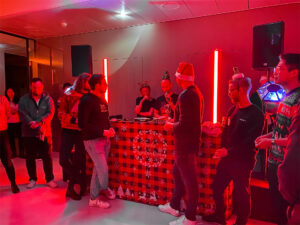
Gifts, gifts, gifts
But it is not only through special performance that you can win at statworx. With our big Christmas raffle everyone had a chance to win. Already a few years ago the raffle was a popular addition to the Christmas party and caused big eyes for the winners. Therefore, it was just the right time to stir the lottery drum again and to raffle off gifts with a total value of 2.500 Euro within the team. From cool prizes like the Airpods Pro Max, interior from vitra and artemide, donation vouchers, merchandising kits and the handmade “Trashy Treasure” (a card game with embarrassing and funny photos from the company history). This year’s well-deserved main winner was our colleague Jannik Klauke, who not only proved to have a lucky hand, but also showed a particularly high level of commitment and thus contributed to the success of the company in 2022 – we would like to take this opportunity to say thank you.
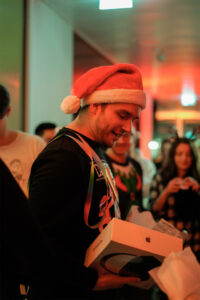
And as if there weren’t enough presents, this year we once again celebrated the traditional Christmas Secret Santa, in which the team gave each other funny, useful and useless gifts. Again, we had great fun! Thanks to the organizers.
Finally, the official part was rounded off by the annual Christmas speech of our CEO Sebastian, whose inspiring content was listened to devoutly by everyone present.
Party, food and good vibes!
A proper sound system is part of a kitchen party. That’s why we had a professional sound setup come and a large DJ booth mounted in the kitchen. Finally, around 9pm, our DJane friend Elisa Cielo arrived (she is very well known in Frankfurt), who had already given us a good kick at the summer party. While we had a lineup of 6 DJs at the summer party, this time we made do with Elisa and her DJ colleague Anton, which also turned out to be a stroke of luck. Cool electronic beats were blasting throughout the conference area and kept us awake until half past four in the morning. We were nourished by numerous sweets brought by the team, tons of pizza and a sensational midnight snack by the girls from “Gudrun Kocht”, who specialize in homemade, natural soups and stews here in Frankfurt – just the thing to fight the hangover.
When the last guests had left, a colleague simply stayed right in the office and did – more or less effectively – night watch.
On Saturday and Sunday, our clean-up team finally arrived and by the time this article was written, our kitchen already looked as if nothing had happened.
We had a great party, are now looking forward to a contemplative time with our families and are already curious when, where and how we will celebrate again in 2023.
With this in mind, we wish all our readers a Merry Christmas and a Happy New Year! Cheers!
As part of the Girls’Day at statworx, we give girls the opportunity to discover the world of artificial intelligence.
On this occasion, we want to inspire girls with the help of exciting lectures and interactive workshops for artificial intelligence and thus show them new career opportunities.
Here’s what we have planned for the Girls’Day:
- Introduction to artificial intelligence (AI) – What is AI?
- AI in everyday life – Where is AI used? When do we interact with AI?
- AI experience – Experimenting with different AI tools
- AI professions – What are they and which skills do I need for them?
You would like to participate?
It’s Christmas time at statworx: Christmas songs are playing during the lunch break, the office is festively decorated and the Christmas party was already a great success. But statworx wouldn’t be a consulting and development company in the area of data science, machine learning and AI if we didn’t bring our expertise and passion to our Christmas preparations.
Surrounded by the smell of freshly baked cookies and Christmas punch, we came up with the idea of developing an AI-based Christmas recipe generator that can complete and visualize texts of any kind using OpenAI models. With GPT-3, the description of a recipe is enough to generate a complete list of ingredients as well as cooking instructions. Afterwards, the complete text is passed as an image description to DALL-E 2, which visualizes it in a high-resolution image. Of course, the application of both models goes far beyond the entertainment factor in day-to-day work, but we believe that a playful get-to-know-you session with the models over cookies and mulled wine is the ideal approach.
Before we get creative together and test the Christmas recipe generator, we will first take a brief look at the models behind it in this blog post.
The leaves are falling but AI is blossoming with the help of GPT-3
The pace of development of large-language models and text-to-image models over the past two years has been breathtaking and swept all of our employees along with it. From avatars and internal memes to synthetic data on projects, not only the quality of the results has changed, but also the handling of the models. Where once there was performant code, statistical analysis, and lots of Greek letters floating around, now the operation of some models almost takes the form of an exchange or interaction. So-called prompts are created by means of texts or keyword prompts.

Fig. 1: Fancy a Christmas punch with a shot? The starting point for this image was the prompt “A rifle pointed at a Christmas mug”. By a lot of trial and error and mostly unexpectedly detailed prompts with many keywords, the results can be strongly influenced.
This form of interaction is partially due to the GPT-3 language model, which is based on a Deep Learning model. The arrival of this revolutionary language model not only represented a turning point for the research field of language modeling (NLP), but incidentally heralded a paradigm shift in AI development: prompt engineering.
While many areas of machine learning remain unaffected, for other areas it even meant the biggest breakthrough since the use of neural networks. As before, probability distributions are learned, target variables are predicted, or embeddings are used, i.e. a kind of compressed neuronal intermediate product, which are optimized for further processing and information content. For other use cases, mostly of a creative nature, it is now sufficient to specify the desired result in natural language and match it to the behavior of the models. More on prompt engineering can be found in this blog post.
In general, the ability of the so-called Transformer models to capture a sentence and its words as a dynamic context is one of the most important innovations. Nevertheless, one must pay attention! Words (in this case cooking and baking ingredients) can have different meanings in different recipes. And these relationships can now be captured by the model. In our first AI cooking experiments, this was not yet the case. When rigid Word2Vec models were used, beef broth or pureed tomatoes might be recommended instead of or along with red wine. Regardless of whether it was jelly for cookies or mulled wine, as the hearty use predominated in the training data!
Christmas image generation with DALL-E 2
In our Christmas recipe generator, we use DALL-E 2 to then generate an image from the completed text. DALL-E 2 is a neural network that can generate high-resolution images based on text descriptions. There are no limitations – the images resulting from the creative word input make the impossible seem possible. However, misunderstandings often occur, as can be seen in some of the following examples.

Fig. 2: Experienced programmers will immediately recognize this: It’s not you, it’s me! Complex, pedantic, or simply logical… Programs usually show us errors or loose assumptions immediately.
Now getting acquainted with the model becomes even more important, because small changes in the prompt or certain keywords can strongly influence the result. Websites like PromptHero collect previous results including prompts (by the way, the experience values differ depending on the model) and give inspiration for high-resolution generated images.

Fig. 3: We wanted to test what was possible and generated cinnamon cookies and gingerbread hawaii with pineapple and ham. The results are still off the scale of taste and dignity.
And how would the model make a coffee at the Acropolis or in a Canadian Indian summer? Or a pun(s)ch with a kick?

Fig. 4: Packs quite the punch.
Complex technology, informal getting to know each other
Enough theory and back to practice.
Now it’s time to test our Christmas recipe generator and have a cooking recipe recommended to you based on a recipe name and an incomplete list of desired ingredients. Creative names, descriptions and shapes are encouraged, unconventional ingredients are strictly desired and model surprising interpretations are almost pre-programmed.
Go to Christmas Recipe Generator
The GPT-3 model used for text completion is so diverse that all of Wikipedia doesn’t even make up 0.1% of the training data and there is no end in sight for possible new use cases. Just open our little WebApp to generate punch, cookie or any recipe and be amazed how far the developments in Natural Language Processing and Text-to-Image have come.
We wish you a lot of fun!
Last month we attended the UXDX EMEA conference in Dublin with a group of project managers from our AI Development department. UXDX stands for user and developer experience, and we were keen to learn more about product management, especially how to accelerate product development. The conference did not disappoint! It was packed with excellent talks and useful workshops. After only a few days we returned home with a wealth of innovative ideas and techniques that we will use to improve our products even further.
Overall, the conference took place over three days and was divided into two parts. The first two days focused on talks, panels, and forums and the third day offered several interesting workshops. We decided to stay for the weekend and do some team building activities on our own time as well.
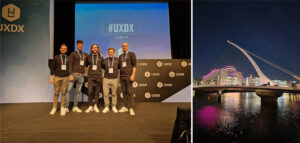
Two full days of talks, panels, and forums
The first two days of the UXDX EMEA conference focused on talks, panels, and forums. While the talks were mostly given by individual speakers sharing their insights on certain topics, panels were made up of several experts discussing these topics from different viewpoints while also including the audience. In forums, attendees engaged in a mediated but otherwise unstructured free-flowing conversation directly with each other. There were always several forums to choose from at the same time and the split into smaller discussion groups encouraged active participation.
One of our personal highlight talks was “From Visual Design to Vision Design: The role of Product Designers in shaping product direction.” This talk provided us with useful insights especially for our larger projects, because it highlighted the importance of also focusing on a longer-term vision over immediate execution. As the project grows, the product team will gradually have more impact on the overall direction of the product, so it is advisable to think about the vision from the start, alongside the short-term goals.
One of the panels that inspired us the most probably was “How leaders can empower their teams”. As a development and consulting company, we organize our project in an agile fashion. This can entail a lot of leeway for the project members on how they want to achieve their tasks. We learnt that modern work requires intrinsic motivation which means that the role of a (project) leader is changing as well, shifting from merely checking off tasks to empowering teams during product development.
A forum that was very informative on development techniques was “Modern Development Principles”, where we critically discussed whether principles such as SOLID should still be adhered to today, and what potential alternatives may be viable for modern software stacks. We also talked about some of the latest insights on topics such as robust software testing methods from a multitude of angles and across different companies.
Overall, we had a great time during the first two conference days and were able to take away a lot of new ideas, insights and techniques regarding both project delivery and product development methods which will help us to further improve our products and how we work together.
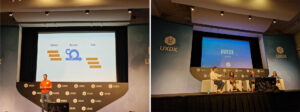
One full day of workshops
On the third and last day of this year’s UXDX EMEA conference we attended several workshops with the overreaching goal for the participants to gain some hands-on experience with new tools and techniques. The workshops tailored to two hours and encouraged collaborative work in small groups. Workshop moderators from leading industry companies such as Figma, AWS, and SAP covered topics reaching from design systems, design debt and structuring complex problems to customer centricity.
The workshop “Breaking Down Complex Problems” led by Rory Madden, Founder of UXDX, was all about identifying problems, how to break them down and how to solve them. One key message of the workshop was that problem identification can be structured by writing out a user journey and breaking down the various steps along the said user journey. In data science this, e.g., helps to think more from the perspective of an end-user rather than the perspective of the developer. Making use of user journeys can also help to identify what aspects of a product are affected by different design choices, thus leading to more founded decisions in scoping a solution to a given problem. Another important topic we gained insight into concerns assumptions. Desirability, viability, feasibility, and usability are the four main directions to consider. A pre-mortem analysis can also lead to additional insights with respect to existing assumptions.
In the workshop “Building Customer-Centric Products” by Daria Tarawneh, Head of UX at AWS, we got insight into the product development approach at AWS. In their approach to product design, they start at the ‘back’ with the user experience and work their way up to the technical implementation from there. A medium used by AWS to ensure customer-centricity, especially in the early phases of product development are press releases. PMs should work on the press release from the beginning of product development, as this ensures that the correct questions have been answered regarding for example who precisely the end users are going to be. During the workshop we therefore also wrote our own press releases. These press releases are not necessarily meant to be published anywhere but are written as if they would. This helps to highlight relevant questions for better product design and development.
Overall, we really enjoyed the workshops as they provided deeper insights into topics of product management and user experience. All discussed problems were tackled in small groups of interdisciplinary teams composed of product managers, UX designers and developers, what provided further insight on how different area deal with different problem settings.
Fun activities during the evenings and weekend
An important aspect of conferences besides talks, forums and workshops are of course networking and getting to know employees and managers of other companies. The organization team of the UXDX EMEA conference in Dublin did a great job with this with activities such as a guided sightseeing tour, a city run for some exercise and a pub crawl.
The whole group of us also decided to extend our stay in Dublin to the weekend as well for some fun team activities. Some of us visited the Guinness Storehouse to learn and taste the local brewing tradition. Later the entire group met up to visit Trinity College and to go to a tasting at the Whiskey Museum in downtown. Did you know that Whiskey basically means water of live? In the evening we went to the Temple Bar district for some food and a couple of beers, a great experience all around.
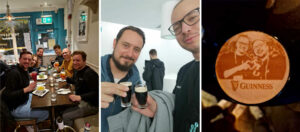
Returning home with a wealth of impressions and ideas
This year’s UXDX EMEA conference in Dublin was an absolute highlight for all of us. The talks, panels, forums, and workshops were all very insightful and informative and we returned home with a wealth of impressions, ideas, and techniques that we will use to improve our products even further. We especially enjoyed the workshops on the importance of customer-centricity and problem identification, two topics crucial to any product design. Overall, we had a great time and highly recommend the UXDX conference format to anyone working in product management. On top of this the conference took place in Dublin, which is a fun place to be in general.
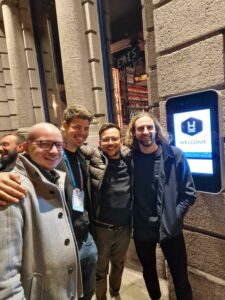
We were at the vuejs.de conference! Why modern JS-based frameworks like Vue.js have become indispensable for the visual representation of data science and UI and what we learned about it in Berlin – that’s what we want to tell you about in this blog post.
According to the State of Javascript survey, Vue.js has been one of the most popular and well-known frontend frameworks for several years now. Particularly noteworthy are the low barrier to entry, the large and active community and the fact that behind the project is not one of the tech giants, but originally only Vue founder Evan You. For these reasons, we at statworx have been involved with the framework for a long time and therefore had great anticipation for the Vue.js Conf 2022 in Berlin.

Our three main impressions of the conference
The conference consisted mainly of half-hour talks, which through their diversity showed the wide range of applications and different uses of Vue.js frontends. More details about the talks can be found here. To reflect the impressions of the conference, we summarize our key takeaways below.
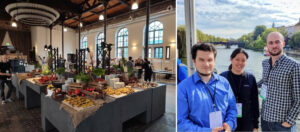
The Vue.js community shows itself to be open, friendly and well organized
The competent speakers are to a large extent members of the Vue.js core team. This and the live Q&A session at the beginning with Evan You, the founder of Vue.js, provided consistently high quality and relevant contributions. Among other topics, this included the latest upgrade from vue2 to vue3 and how to deal with legacy projects and how to transition them.
The venue “Bolle Festsäle” was also a good choice as it provided a friendly and lively atmosphere. The organizing team also proved to have a good hand for food and drink, so varied tasting was provided every hour. So the stage for a successful conference was set right from the start!
The many live coding sessions within the talks also showed that the community, characterized by the open source idea, is open-minded, helpful and open to discussion. The fact that even members of the core team make simple mistakes while coding (surely only due to the fact that they are coding live in front of a large audience) also encourages them not to be too critical of their own mistakes.
Testing increases confidence in developed frontends
The contributions of Debbie O’Brien and Markus Oberlehner dealt with the topic of testing frontends. The speakers’ statement that testing is an important component that should not be neglected but should be integrated from the beginning of a project, met with open ears and agreement in the audience. In addition to the common tools Cypress and Vitest, new tools such as Playwright were presented and tips and tricks for their use were discussed. It became clear that there is no “one” tool that can do everything, but that the combination and goal-oriented application is decisive. In addition to testing the functionality, testing should often provide fast feedback so that bugs and errors can be found and corrected quickly.
Thus, it is not only a matter of “how” testing is done, but also of “what” is done. In the subsequent discussion with Markus Oberlehner, our attitude that testing – like so many things – does not have a pattern was confirmed. Instead, the experience and expertise of a developer are required to write the right tests with the right tools.
Training also takes place during the break
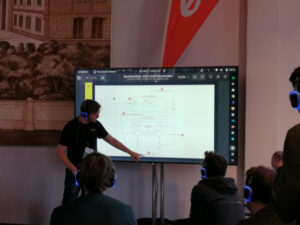
During the lunch and coffee breaks, there were other opportunities for education and networking in addition to the catering. For example, there was a “live hacking” of a demo webpage that exploited a security vulnerability to get the administrator’s access token out. The exploited vulnerability was the unverified user input. Malicious HTML code was inserted into the user input field instead of login credentials, which, when executed, accessed sensitive information such as the access token. Since the user input was left unchecked, the malicious HTML code could be executed. This type of attack is called a cross-site scripting (XSS) attack. The demo showed the importance of careful sanitization and validation of user input by developers to protect against such attacks.
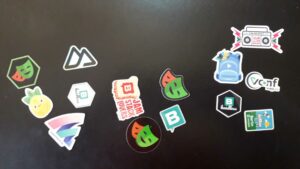
From the conference back to everyday life
The well-paced presentations of the one-day vuejs.de conference made for a full program that leaves you wanting more. Therefore, we return with new ideas and a zest for action and try to let the impressions take effect. True to one of our statworx company values “We grow though challenge”, we will continue to work on our projects to reconcile the numerous and complex tasks. Because:
A well-designed, tested and secure frontend can immensely increase the value of a Data Science application, as it is the first (and often the only) contact for the user to the underlying model.
